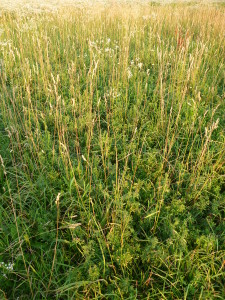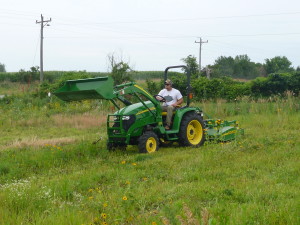Specific Questions
The specific topics we will examine with the Prairies For Agriculture Project can be divided into several broad questions:
Creating Benefits in the Agricultural Landscape: Which specific mixes of plants provide the most benefit when planted on un-farmable sites in the Midwest? Stated another way: Are prairie plants more beneficial when planted on un-farmable sites in the agricultural landscape than the non-native plants often planted there? Additionally, does increasing the diversity of species used in a planting lead to more benefits? Specific benefits we will assess will include the following:
- consistently producing biomass for fuel production and livestock forage.
- producing forage with maximum food value for livestock.
- storing carbon in the soil.
- increasing water content in the soil, especially during dry conditions.
- increasing soil nutrients including phosphorus, nitrogen, and carbon.
- reducing soil erosion.
- reducing surface runoff of phosphorus originating from fertilizers.
- reducing atmospheric release of nitrogen originating from fertilizers.
- increasing populations of pollinators and other beneficial insects in the agricultural landscape.
- increasing use by animals including game species and organisms with declining populations in the Midwest.
Some combinations of plants may be better than others at providing these benefits. Some of the specific mixes of plants we will test include the following:
- five dominant warm-season grasses (Indiangrass, switchgrass, sideoats grama, big and little bluestem)
- five dominant warm-season grasses plus one species of legume (this represents nine different plant mixes because we are using nine species of legumes, each of which will be used with the five grasses)
- five dominant warm-season grasses plus 2, 3, 6, 7, or 9 species of legumes
- five dominant warm-season grasses plus 1, 3, 6, or 9 non-leguminous forbs
- five dominant warm-season grasses plus three cool-season grasses
- high versus low family diversity plots – 16 species (in 4 families) versus 16 species (in 8 families)
- 16 species with inexpensive seeds / 24 species with inexpensive seeds
Planting Methods: Many recommendations for planting prairies are available in the literature. We are testing several of these recommendations including the following:
- How important is it to rake and compact the seeds after planting?
- How important is it to mow prairie plantings during their first growing season? Is it beneficial to mow for the first and second growing seasons?
- Is it more beneficial to plant in fall or spring?
- Which species are most likely to germinate from seed and survive?
Drought: During the first two growing seasons of our project, our site experienced severe to extreme drought conditions. Therefore, all of the questions about planting methods will be interpreted in relation to drought conditions. Very little information is available about successful planting of prairies during droughts, which are expected to become more common in the future.



